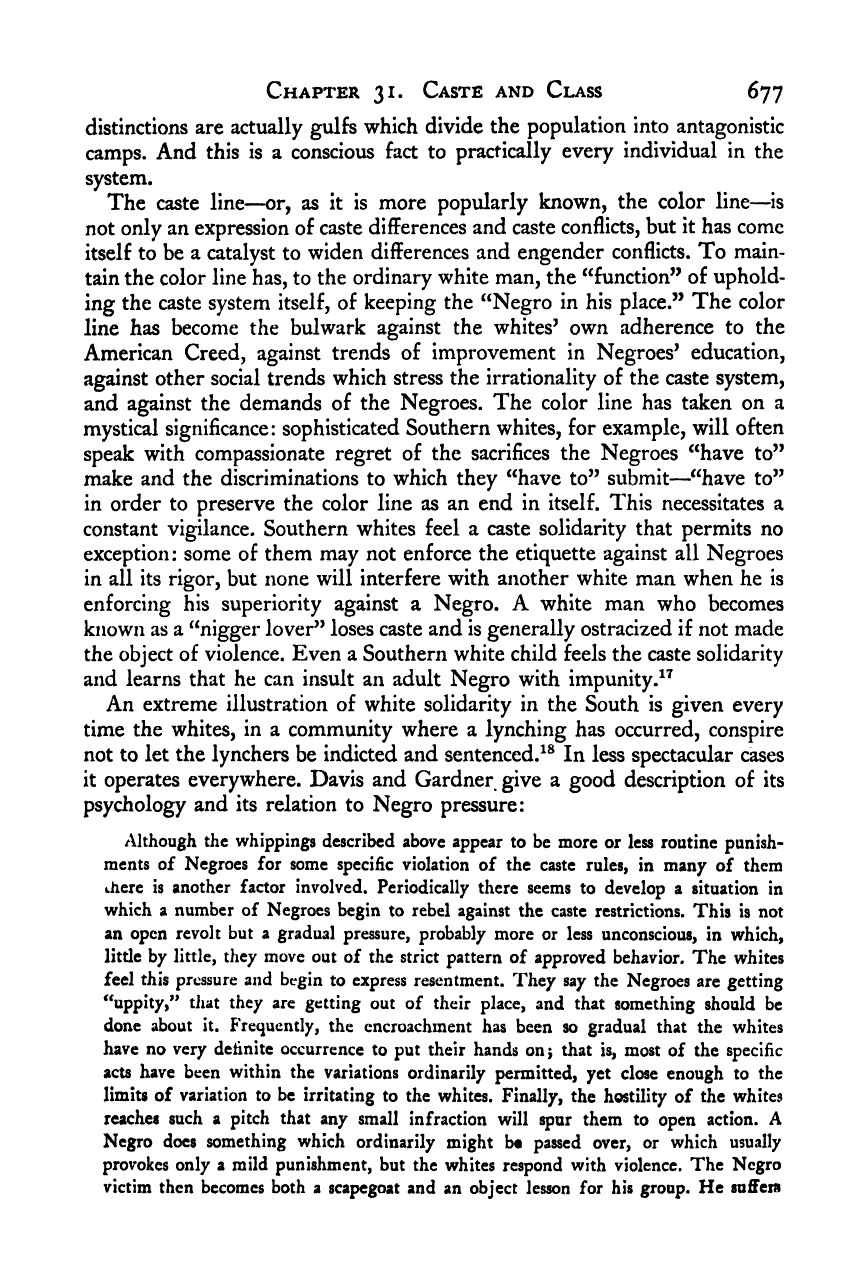Note: Gunnar Myrdal died in 1987, less than 70 years ago. Therefore, this work is protected by copyright, restricting your legal rights to reproduce it. However, you are welcome to view it on screen, as you do now. Read more about copyright.
Full resolution (TIFF) - On this page / på denna sida - VIII. Social Stratification - 31. Caste and Class - 3. The Caste Struggle

<< prev. page << föreg. sida << >> nästa sida >> next page >>
Below is the raw OCR text
from the above scanned image.
Do you see an error? Proofread the page now!
Här nedan syns maskintolkade texten från faksimilbilden ovan.
Ser du något fel? Korrekturläs sidan nu!
This page has never been proofread. / Denna sida har aldrig korrekturlästs.
Chapter 31. Caste and Class 677
distinctions are actually gulfs which divide the population into antagonistic
camps. And this is a conscious fact to practically every individual in the
system.
The caste line—or, as it is more popularly known, the color line—is
not only an expression of caste differences and caste conflicts, but it has come
itself to be a catalyst to widen differences and engender conflicts. To main-
tain the color line has, to the ordinary white man, the “function” of uphold-
ing the caste system itself, of keeping the “Negro in his place.” The color
line has become the bulwark against the whites’ own adherence to the
American Creed, against trends of improvement in Negroes’ education,
against other social trends which stress the irrationality of the caste system,
and against the demands of the Negroes. The color line has taken on a
mystical significance: sophisticated Southern whites, for example, will often
speak with compassionate regret of the sacrifices the Negroes “have to”
make and the discriminations to which they “have to” submit—“have to”
in order to preserve the color line as an end in itself. This necessitates a
constant vigilance. Southern whites feel a caste solidarity that permits no
exception: some of them may not enforce the etiquette against all Negroes
in all its rigor, but none will interfere with another white man when he is
enforcing his superiority against a Negro. A white man who becomes
known as a “nigger lover” loses caste and is generally ostracized if not made
the object of violence. Even a Southern white child feels the caste solidarity
and learns that he can insult an adult Negro with impunity.^^
An extreme illustration of white solidarity in the South is given every
time the whites, in a community where a lynching has occurred, conspire
not to let the lynchers be indicted and sentenced.^® In less spectacular cases
it operates everywhere. Davis and Gardner, give a good description of its
psychology and its relation to Negro pressure:
Although the whippings described above appear to be more or less routine punish-
ments of Negroes for some specific violation of the caste rules, in many of them
there is another factor involved. Periodically there seems to develop a situation in
which a number of Negroes begin to rebel against the caste restrictions. This is not
an open revolt but a gradual pressure, probably more or less unconscious, in which,
little by little, they move out of the strict pattern of approved behavior. The whites
feel this pressure and begin to express resentment. They say the Negroes are getting
‘‘uppity,” tJiat they arc getting out of their place, and that something should be
done about it. Frequently, the encroachment has been so gradual that the whites
have no very definite occurrence to put their hands on 5 that is, most of the specific
acts have been within the variations ordinarily permitted, yet close enough to the
limits of variation to be irritating to the whites. Finally, the hostility of the whites
reaches such a pitch that any small infraction will spur them to open action. A
Negro does something which ordinarily might be passed over, or which usually
provokes only a mild punishment, but the whites respond with violence. The Negro
victim then becomes both a scapegoat and an object lesson for his group. He suffeia
<< prev. page << föreg. sida << >> nästa sida >> next page >>